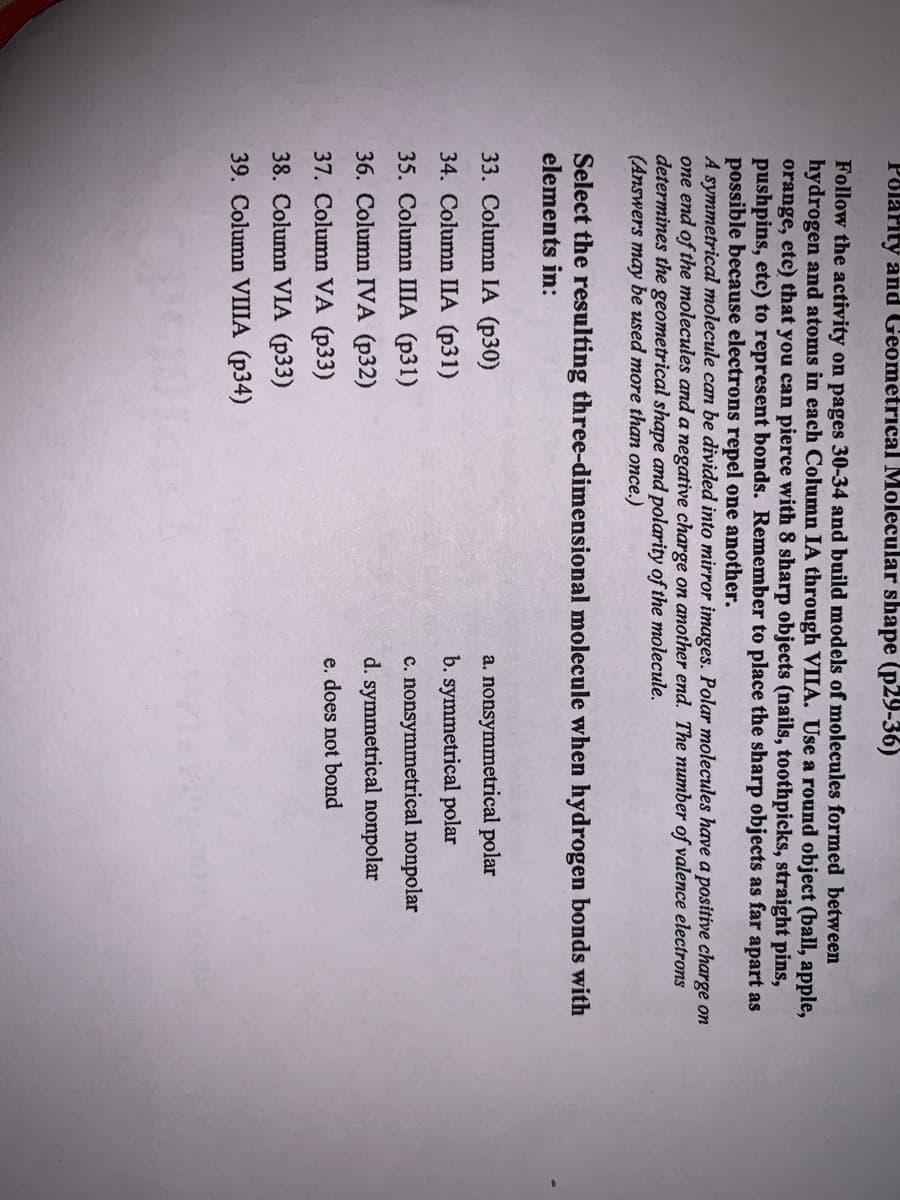(Answers may be used more than once.) Select the resulting three-dimensional molecule when hydrogen be elements in: 33. Column IA (p30) a. nonsymmetrical polar 34. Column IIA (p31) b. symmetrical polar 35. Column IIIA (p31) c. nonsymmetrical nonpolar 36. Column IVA (p32) d. symmetrical nonpolar 37. Column VA (p33) e. does not bond 38. Column VIA (p33) 39. Column VIIIA (p34)
(Answers may be used more than once.) Select the resulting three-dimensional molecule when hydrogen be elements in: 33. Column IA (p30) a. nonsymmetrical polar 34. Column IIA (p31) b. symmetrical polar 35. Column IIIA (p31) c. nonsymmetrical nonpolar 36. Column IVA (p32) d. symmetrical nonpolar 37. Column VA (p33) e. does not bond 38. Column VIA (p33) 39. Column VIIIA (p34)
Introduction to General, Organic and Biochemistry
11th Edition
ISBN:9781285869759
Author:Frederick A. Bettelheim, William H. Brown, Mary K. Campbell, Shawn O. Farrell, Omar Torres
Publisher:Frederick A. Bettelheim, William H. Brown, Mary K. Campbell, Shawn O. Farrell, Omar Torres
Chapter3: Chemical Bonds
Section: Chapter Questions
Problem 3.125P
Related questions
Question

Transcribed Image Text:Polarity and Geometrical Molecular shape (p29-36)
Follow the activity on pages 30-34 and build models of molecules formed between
hydrogen and atoms in each Column IA through VIIA. Use a round object (ball, apple,
orange, etc) that you can pierce with 8 sharp objects (nails, toothpicks, straight pins,
pushpins, etc) to represent bonds. Remember to place the sharp objects as far apart as
possible because electrons repel one another.
A symmetrical molecule can be divided into mirror images. Polar molecules have a positive charge on
one end of the molecules and a negative charge on another end. The number of valence electrons
determines the geometrical shape and polarity of the molecule.
(Answers may be used more than once.)
Select the resulting three-dimensional molecule when hydrogen bonds with
elements in:
33. Column IA (p30)
a. nonsymmetrical polar
34. Column IIA (p31)
b. symmetrical polar
35. Column IIIA (p31)
c. nonsymmetrical nonpolar
36. Column IVÀ (p32)
d. symmetrical nonpolar
e. does not bond
37. Column VA (p33)
38. Column VIA (p33)
39. Column VIIIA (p34)
Expert Solution
This question has been solved!
Explore an expertly crafted, step-by-step solution for a thorough understanding of key concepts.
This is a popular solution!
Trending now
This is a popular solution!
Step by step
Solved in 2 steps with 1 images

Knowledge Booster
Learn more about
Need a deep-dive on the concept behind this application? Look no further. Learn more about this topic, chemistry and related others by exploring similar questions and additional content below.Recommended textbooks for you

Introduction to General, Organic and Biochemistry
Chemistry
ISBN:
9781285869759
Author:
Frederick A. Bettelheim, William H. Brown, Mary K. Campbell, Shawn O. Farrell, Omar Torres
Publisher:
Cengage Learning


Organic Chemistry
Chemistry
ISBN:
9781305580350
Author:
William H. Brown, Brent L. Iverson, Eric Anslyn, Christopher S. Foote
Publisher:
Cengage Learning

Introduction to General, Organic and Biochemistry
Chemistry
ISBN:
9781285869759
Author:
Frederick A. Bettelheim, William H. Brown, Mary K. Campbell, Shawn O. Farrell, Omar Torres
Publisher:
Cengage Learning


Organic Chemistry
Chemistry
ISBN:
9781305580350
Author:
William H. Brown, Brent L. Iverson, Eric Anslyn, Christopher S. Foote
Publisher:
Cengage Learning

Organic Chemistry: A Guided Inquiry
Chemistry
ISBN:
9780618974122
Author:
Andrei Straumanis
Publisher:
Cengage Learning

Chemistry: The Molecular Science
Chemistry
ISBN:
9781285199047
Author:
John W. Moore, Conrad L. Stanitski
Publisher:
Cengage Learning